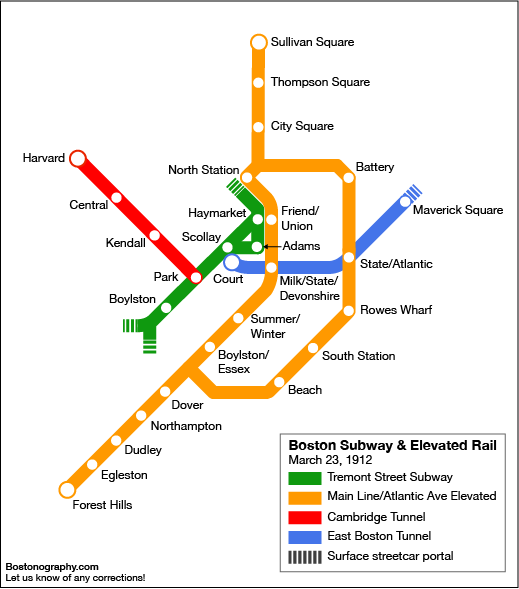Do you live, work, or ever travel in the area between Harvard Square and Park Street? If so, you know a piece of the MBTA Red Line that celebrates its 100th birthday today!
Yes, what is now the Red Line between Harvard and Park Street—the Cambridge Tunnel, the Longfellow Bridge and short elevated rail over Charles Circle, and the tunnel under Beacon Hill, opened on March 23, 1912 as part of the Boston Elevated Railway’s system. This was the last of the present-day four subway lines to begin operation, the underground sections of the current Green, Blue, and Orange lines having been started in 1897, 1904, and 1908 respectively. The Green Line’s Tremont Street subway is of course famously the oldest subway in the United States. (Note, however, that the Tremont Street and East Boston subways were built for streetcars, making the Cambridge Tunnel the second heavy rail tunnel in Boston, after Washington Street.)

Here is a map of rail rapid transit that existed 100 years ago today, with some approximation and no doubt some mistakes, using the modern style and colors. The Red Line gradually extended south into Dorchester through the 1920s and later to the South Shore and Alewife in the 1970s and 80s.
The Cambridge Tunnel opened as part of a system rather different from what it is today. Besides all the sections yet to be built, there were significant lines that no longer exist: the Charlestown, Washington Street, and Atlantic Avenue elevated lines, the first two making up most of the Orange Line before its relatively recent realignments. The “oldest transit system in the country” excuse is often invoked to explain maintenance difficulties, but a 1912 snapshot shows that 100 years ago—when other cities had well-established transit systems—most of the current configuration did not exist. What Boston has is the oldest subway, the relatively short Tremont Street subway, not really the oldest system. Great chunks of it date no further back than the 1970s and 80s. The Red Line section that recently saw weekend closures to fix its deplorable conditions, for example, opened only 27 years ago. For a more complete history, check out this excellent series of maps showing the extent of Boston transit by decade, including the great network of streetcar lines that used the tunnels, most of which no longer exists.
Thinking about the occasion from a geographic perspective, as is our wont, it’s interesting to study the news coverage of the opening of this “big tube” in 1912. Tim has found some old articles about this and other transit events of the era—check out a PDF collection not only for subway coverage but also because old-timey newspapers have hilarious advertisements for all sorts of quackery. Anyway, much is made of the short travel time—eight minutes—between Harvard Square and Park Street as compared to surface options. The word “suburbanites” appears in a few places too, remarking on how easy it now was for people in idyllic, faraway Cambridge to get to the big city. Things have changed. First of all, eight minutes is unlikely, what with an extra station (Charles) and what I guess must be a sharper (i.e. slower) turn than used to exist at Harvard. The city/suburb situation isn’t the same, either. As populations have dispersed, the core city isn’t just those very densest downtown regions but rather extends to places once called suburbs. Harvard Square itself is now a major node in the core urban area and is home to the third-busiest MBTA station in the whole system. The subway is no longer a way to get between city and suburb; it’s a way to move around within the city.
Don’t forget to celebrate again on Monday for the 156th anniversary of the first horsecar line. Then start planning your next transit celebrations for June 1, the 100th birthday of the Lechmere Viaduct, which will carry trains to the next planned system expansion, the Green Line through Somerville. And as you grumble about the endless delays and escalating cost of that yet-to-be-started extension, consider this and grumble more: since the opening of the Tremont Street subway in 1897, this is the longest we’ve gone with no real expansion of rail rapid transit.
Party hard today, Red Line riders, and enjoy your commute!

Nice map! I’ve done considerable research and writing about the history of the subway but have never thought about doing up a map in the modern style.
Thanks! Give a shout if you’ve spotted any errors in the map based on what you know.
I’ve enjoyed all the history, photographs, and so forth on your blog, by the way!
Close, but the Washington St subway (Orange Line) had separate names for each platform.
Haymarket: Friend-Union
State St: Milk-State
Essex: Boylston-Essex
Thanks, I’d thought so, but I must have been going off some source that didn’t list those. Updated the image with those names now.
On the date that the present day Red Line opened, the Green Street elevated station had not opened yet. It would open on September 11 later that year. Other than that, you are completely correct.
Thanks, James. I’ll drop that station from the map.
As the author of the series of maps you link showing Boston rapid transit each decade, I’d like to note that they only show streetcar lines which used the Tremont Street or East Boston subways. There were quite a few more streetcar routes that ran only at surface level (see http://en.wikipedia.org/wiki/File:BERy_1925_map.jpg for an idea, though there were even more in earlier years).
Ah, good to know—thanks for the clarification. And thanks so much for making those maps. Great work, and very informative!
Pingback: vanshnookenraggen blog » Blog Archive » An Animated History of the MBTA
Pingback: Getting Around Boston – the T Subway System « metrobabel